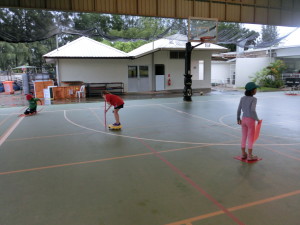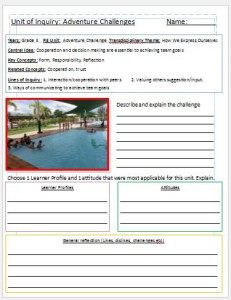Adventure Challenges – Transportation
In this unit, students attempt to complete challenges that focus on movement and transportation working in small and large groups.
Prior Knowledge
This first challenge is called Escape the Island and there are a number of versions in this challenge. I give each team 2 scooter-boards, 2 ropes and 1 pole per group. Students are then instructed, “To try and make their way to their corner using the equipment provided. if a student touches the ground in between, then that student must return to the island and start again.” As I use this learning engagement for gathering prior knowledge I left the instructions simple and as indicated above without explicitly asking them to make a plan first etc.
Bean Bag Relay
All students begin in the middle of the basketball court in the centre circle, there are 4 distinct teams and lots of bean bags (40+). Each team must use their equipment (stepping stones or hoops) to make a pathway to their goal (another hoop in their corner of the court). The only rules are as follows, a) If a students touches the ground, the student and bean bag must return to the centre circle, b) A team can only pick up a second bean bag once another one has been placed in their goal (hoop). The challenge is finished when all the bean bags are collect or if time restricts, when a certain amount of time is up.
All teams start in the centre circle Students begin to make their way out
Students try many ways to ferry out But a team does discover the relay system
Playground Obstacle Course
In this challenge, the teacher must first design a short obstacle course using parts of the school playground. Eg. up the stairs, down a slide, across the monkey bars. Having a number of different short courses allows students to try different obstacle courses. Once the students have tried it individually (they should be able to complete this easily), the students will be paired up and connected using tails belts. Then the pair (now connected) must try and navigate their way through the obstacle course again without being disconnected. The pair should try all courses before returning to the start and regrouping in to groups of 3. Again, the group of 3 must now navigate their way through the obstacle course staying connected. If time permits, students can be regrouped to larger groups (4-5) to try the obstacle course again and again.
Begin individually, then pair up… Add another and try again.
Summative Assessment
The summative assessment task for this unit was twofold, one practical component and a written reflection.
Practical: Raft building challenge – The students will be divided in to two teams an given the same amount of equipment. 4 X ropes, 6 X noodles and 1 X kickboard (life jackets optional). The students must work as a team to initially build a raft that can float the students and secondly, to transfer all team members from one side of the pool to the other. The students legs can touch water but if they fall off or water goes above their waist, they must return to the beginning.
Teams begin to build a raft The first person in the group ventures out
Students help one-another at either end. Ropes on front & back of raft are fastest
Written Assessment Task: All students will be asked to choose from the learning experiences throughout the unit and asked to choose one challenge to focus on. After choosing, the students will be asked to draw and label a diagram of that challenge and how the team worked (or didn’t) as a group to complete the task.
Other Challenges – Some of the other challenges in this unit (without photographs) are described below. It can be tricky to get good photographs for swimming sessions due to being in the water a lot during these sessions.
P.E
Bridge building Challenge – Using various objects that can be stood on (mats, gymnastics vaults, stepping stones etc) students must build a bridge that they can use to cross an imaginary river on. The object is to continuously build the bridge as the group moves along. The group will need to build as much of the bridge as possible, walk out as far as they can and then start removing sections from the back to bring to the front so the bridge continues to move forwards. Students not allowed to step off or out of equipment being used to build bridge. Teachers could choose if students need to start again or give a time penalty for stepping off the bridge.
Capture the Flag – A classic game played indoors/outdoors where the students are divided in to two teams in different colours to distinguish the players. A team wins when they capture their opponent’s flag. To capture the flag a player must enter the opponents territory take the flag and bring it back to their territory without being captured (tagged). If a player is caught in their opponent’s territory by being tagged they are brought to jail. They can only escape jail if one of their teammates is able to elude defenders and reach the jail safely. When this happens the player can choose to rescue one of his teammates and they have a free trip back to their territory.
Swimming
Team Relays – In this water based challenge, the students will be divided in to groups of 4-5, depending on numbers to make even teams. The first challenge is the tunnel relay similar to tunnel ball in P.E. Students line up in a straight line and make a tunnel with their legs, the student at the back swims through the tunnel to the front and the group starts moving forward. This is repeated until teams reach the other side of the pool. Relay 2 is the Chariot relay.where students begin in a straight line again. This time, the person at the front of the line will piggy back the second student (facing back to back) up and down the pool. The first student will drop the second student off who now turns to pick up the third student in line. This is repeated until everyone has had a turn both carrying and being carried. Relay 3 is the rescue relay and works in a similar way to relay 2 however this time, the first person in line transports the next student up and down the pool using the life saving backstroke technique (with frog kick). Again all students take a turn in both being carried and carrying someone else.
Changing Clothes Relay – Before beginning this relay, use one of the previous weeks relays as a warm up for this weeks relay. Once complete, divide the students in to equal groups and explain that the relay format used last week will be used again. This time however, students have a pair of shorts/pants and a top to put on before swimming up and down the pool (this can also be done across a pool depending on the size of the pool). As one student returns, he/she must remove the clothes they are wearing over the top of their bathers (swim suit) and pass to the next team member who must put the clothes on before repeating the pattern until all students have swum their part of the relay with the clothes on. If time permits in the lesson, complete another relay from the previous week again.
Treasure Hunters Relay – In this relay you will need some old coins, the smaller the better. Beginning with the small pool, students will participate in a brief introduction to swimming with a snorkel and mask, focusing on the mask to search for items. Then using the large pool, students are divided in to pairs and must work as a team to collect as many coins from the bottom of the pool as possible (coins already thrown in the pool before lesson begins). The students must work in pairs however by one person having the snorkel and mask to locate the coins and their partner (no goggles/snorkel) is actually the student to pick the coins up. Once a team has a coin the must return it to their area (or bucket) before going to retrieve another coin. The game continues until all coins have been retrieved. Teacher can decide if students count their coins to determine a winner or simply collect the coins and ask students to share their technique for this activity.
Freight Train Relays – This challenge is based on the swimming exercise of students joining up to swim together. Eg. person A at the front uses his/her arms to propel whilst person B holds on to the legs of person A but person B does the kicking part. So together, they are using both arms and legs to swim through the water. To begin, the students should have a trial run of swimming as a train. Once the practice run is complete, the students are informed that their challenge is to transport noodles/kick-boards (whatever personal flotation devices are available – PFD’s) from one end of the pool to the other. Using their body as a train, they must load up their cargo somewhere on their bodies and swim to transport the PFD’s from one end of the pool to the other. Again, this challenge could be set up as a race to see which team transports the most PFD’s the quickest or simply be given a certain number of PFD’s to transport in a period of time, depending on the nature of the group.



















